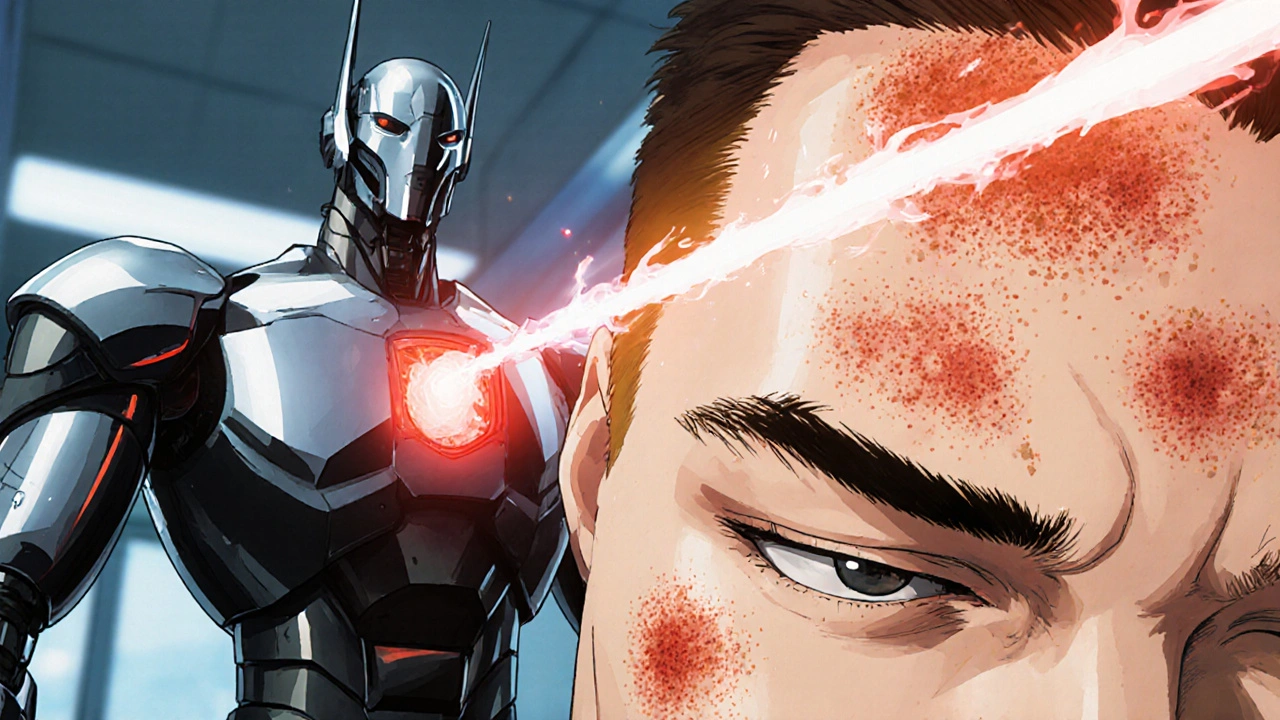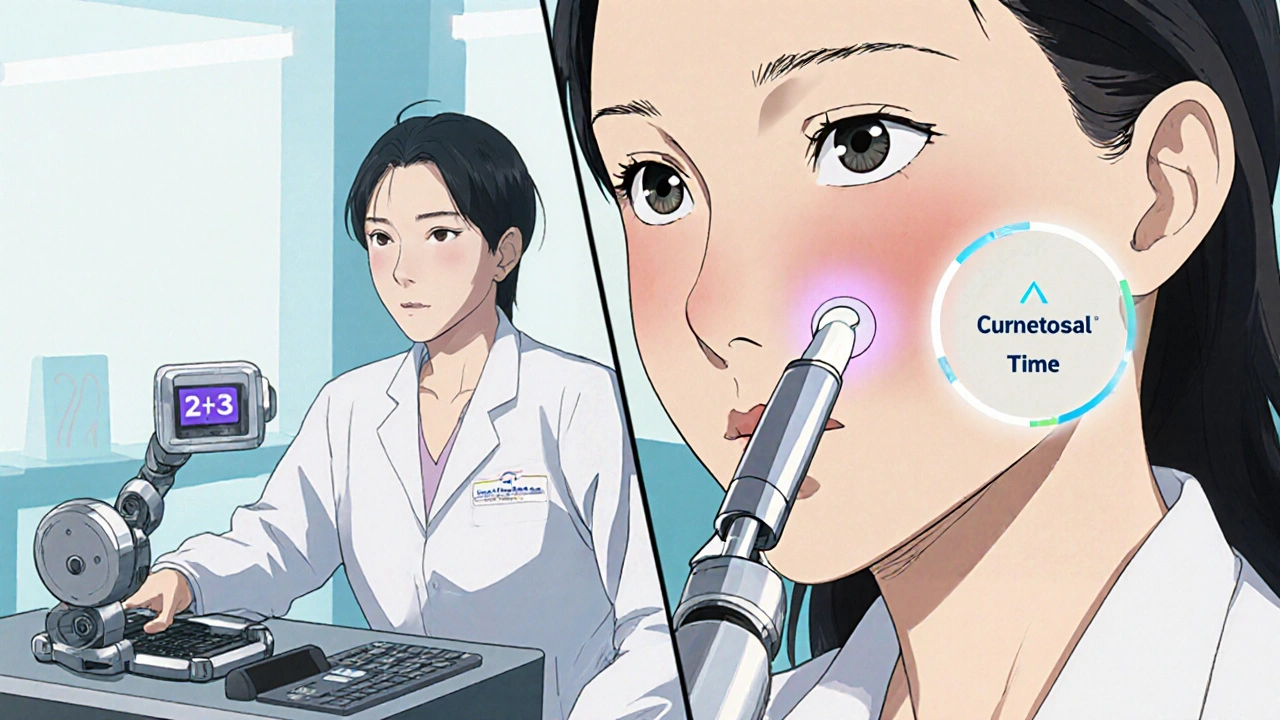
Clobetasol Treatment Duration Calculator
Calculate Safe Clobetasol Usage
This tool helps determine appropriate treatment duration based on medical guidelines for clobetasol propionate use in seborrheic dermatitis.
When doctors treat severe skin flare‑ups, Clobetasol propionate is a super‑potent topical corticosteroid that reduces inflammation and itching. It belongs to the class‑I steroid group and is typically available in cream, ointment, and scalp‑solution forms. is often mentioned in discussions about Seborrheic dermatitis. Seborrheic dermatitis is a chronic, relapsing dermatitis that primarily affects oily areas of the skin such as the scalp, eyebrows, and chest, and is linked to the yeast Malassezia. Many patients wonder whether that powerful steroid can tame the red, flaky patches that keep coming back.
What exactly is seborrheic dermatitis?
Seborrheic dermatitis (SD) is more than just a stubborn dandruff problem. It shows up as greasy‑looking scales, red patches, and occasional itching. The condition thrives in zones with abundant sebaceous glands because the oil creates a perfect breeding ground for Malassezia species. While the exact trigger is still under research, most experts agree on a three‑part model: excess sebum, yeast overgrowth, and an abnormal immune response.
Typical hotspots include:
- Scalp - the classic “dandruff” presentation.
- Face - especially the eyebrows, nasolabial folds, and ears.
- Upper chest and back - often mistaken for eczema.
Flare‑ups can be aggravated by stress, cold weather, hormonal changes, or harsh hair products. In severe cases, the skin may crack, bleed, or become secondarily infected.
How does clobetasol work on the skin?
Clobetasol’s main job is to shut down the inflammatory cascade that fuels redness and itching. It binds to glucocorticoid receptors inside skin cells, which then travel to the cell nucleus and switch off genes that produce pro‑inflammatory cytokines. The result is rapid reduction of swelling, erythema, and immune‑mediated irritation.
Because it’s a class‑I (very high‑potency) steroid, it can suppress the local immune response more strongly than milder options like hydrocortisone or betamethasone. This makes it effective for short‑term control of stubborn skin lesions, but also raises the stakes for side‑effects if used incorrectly.
When do doctors actually prescribe clobetasol for SD?
Clinical guidelines reserve clobetasol for “recalcitrant” or “acute‑exacerbation” cases where first‑line treatments have failed. Typical scenarios include:
- Persistent scalp plaques that do not improve after 2-4 weeks of antifungal shampoo (e.g., ketoconazole 2%).
- Inflammatory plaques on the face or chest that are thick, red, and painful.
- When a patient’s quality of life is significantly affected by itching or visible lesions.
Dermatologists will usually limit clobetasol use to a 2‑week burst, sometimes followed by a tapering schedule. After the high‑potency phase, they often switch patients to a lower‑potency steroid or a non‑steroidal option to maintain remission.

How to use clobetasol safely - a step‑by‑step guide
Following a proper application routine lowers the risk of skin thinning, hormone suppression, and other complications. Here’s a practical checklist:
- Get a prescription. Buy only from a licensed pharmacy; avoid online “no‑prescription” sources.
- Clean the area. Gently wash with a mild, fragrance‑free cleanser and pat dry.
- Apply a thin layer. Use just enough to cover the affected skin - roughly the size of a pea for each patch.
- Rub in gently. Do not scrub; let the medication absorb fully (about 2-3 minutes).
- Wash hands afterwards. Prevent accidental transfer to the eyes or other body parts.
- Limit frequency. Most regimens call for once‑daily application, often at night.
- Track the duration. Mark the start date on a calendar and set a reminder to stop after the prescribed period.
For scalp use, a “scalp solution” can be massaged in, left on for 30 minutes, then washed out. For facial lesions, a cream or ointment works better because it stays in place.
Alternatives and how they compare
If you’re hesitant about a super‑potent steroid, there are several other options that target different parts of the SD puzzle. Below is a quick side‑by‑side look.
| Product | Potency / Class | Typical Use | Prescription? | Main Side Effects |
|---|---|---|---|---|
| Clobetasol propionate | Class‑I (very high) | Severe plaques, short‑term flare control | Yes | Skin atrophy, telangiectasia, adrenal suppression |
| Ketoconazole 2% shampoo | Antifungal | Scalp maintenance, mild‑to‑moderate SD | No (OTC in many countries) | Dryness, irritation |
| Hydrocortisone 1% cream | Class‑VI (low) | Mild inflammation, maintenance phase | No (OTC) | Minimal; possible mild burning |
| Tea tree oil 5% solution | Natural antiseptic | Adjunct for mild flares | No | Allergic dermatitis in sensitive skin |
Notice how clobetasol sits at the top for potency but also carries the most serious warnings. Most dermatologists start with ketoconazole shampoo, add a low‑potency steroid if needed, and only reach for clobetasol when those measures aren’t enough.

Potential side effects and red‑flag warnings
Because clobetasol can suppress the skin’s natural defenses, you should watch for these signals:
- Visible thinning or stretch marks on the treated area.
- Persistent redness or a “rosy” hue that doesn’t fade.
- Development of small blood vessels (telangiectasia) that look like spider veins.
- Easy bruising or delayed wound healing.
- Signs of systemic absorption: unusual fatigue, dizziness, or unexplained weight loss.
If any of these appear, stop the medication immediately and contact your dermatologist. In rare cases, prolonged high‑potency steroid use can affect the hypothalamic‑pituitary‑adrenal (HPA) axis, leading to cortisol imbalance. This is why the treatment window is kept short and why a tapering plan is essential.
Frequently asked questions
Can I use clobetasol on my scalp every day?
Short‑term daily use (usually 1-2 weeks) is acceptable for severe flare‑ups. After that period, most doctors recommend either pausing the treatment or switching to a lower‑potency steroid to avoid skin thinning.
Do I need a prescription for clobetasol in Australia?
Yes. In Australia, clobetasol propionate is a Schedule 4 medication, meaning it must be prescribed by a qualified health professional and dispensed by a pharmacy.
Is it safe to combine clobetasol with antifungal shampoo?
Combining the two is a common strategy. The antifungal shampoo tackles the yeast component, while clobetasol quickly reduces inflammation. Just follow the timing instructions: apply the steroid after the shampoo has dried.
What should I do if I miss a dose?
Apply the missed dose as soon as you remember, unless it’s close to the next scheduled dose. In that case, skip the missed one and resume your normal schedule. Do not double‑dose.
Can clobetasol cause permanent skin damage?
Permanent damage is rare if the medication is used as prescribed. Chronic over‑use can lead to lasting atrophy or stretch marks, which is why short courses and medical supervision are crucial.
Bottom line - should you try clobetasol for seborrheic dermatitis?
If you’ve exhausted milder shampoos, low‑potency steroids, and lifestyle tweaks, a short, doctor‑guided course of clobetasol can provide rapid relief. The key is to treat it as a “burst” therapy-use it for no more than the prescribed 2 weeks, monitor the skin closely, and then transition to a gentler maintenance plan.
Remember, the most sustainable strategy tackles the three pillars of SD: control yeast growth, reduce excess oil, and calm the immune response. Clobetasol addresses the last pillar powerfully, but it does nothing for the yeast or oil side. Pair it with an antifungal shampoo like ketoconazole and a non‑comedogenic cleanser, and you’ll have a balanced attack that minimizes the need for repeated steroid courses.
clobetasol isn’t a first‑line cure, but in the right hands and the right situation, it can be a game‑changer for those who suffer from stubborn seborrheic dermatitis.

Shermaine Davis
October 23, 2025 AT 23:04I totally get how frustrating seborrheic dermatitis can be. Using clobetasol for just a short burst can really calm the itching, but you’ve gotta follow the doctor’s plan. Remember thier skin needs a break after the two weeks.
Kristin Violette
November 1, 2025 AT 06:30From a pharmacodynamic perspective, clobetasol propionate exerts its effects via glucocorticoid receptor agonism, resulting in transcriptional repression of pro‑inflammatory cytokines such as IL‑1β and TNF‑α. In acute exacerbations, the rapid attenuation of the NF‑κB pathway translates to noticeable reduction in erythema within 48‑72 hours. However, the high‑potency class‑I status mandates vigilant monitoring for iatrogenic adrenal axis suppression. Clinicians often employ a “pulse‑taper” protocol: a 2‑week induction followed by a gradual down‑step to a mid‑potency steroid or a calcineurin inhibitor. This strategy balances efficacy with safety, especially when the lesional burden is extensive.
Diane Larson
November 9, 2025 AT 13:06One practical tip is to apply the cream only to the active plaque and avoid the surrounding healthy skin; that minimises unnecessary exposure. Use a pea‑size amount per 2‑inch patch and gently pat it in – don’t rub hard, you’ll risk mechanical irritation. Pair the steroid regimen with a ketoconazole 2 % shampoo twice weekly to keep the Malassezia load under control. Moisturize with a non‑comedogenic, fragrance‑free emollient after the steroid has fully absorbed; this helps restore the barrier and reduces rebound flares. If you notice any thinning or telangiectasia, stop the steroid and discuss alternative therapies like pimecrolimus with your dermatologist.
Michael Kusold
November 17, 2025 AT 19:43i kinda think the short‑term burst is ok but dont overdo it. best to keep an eye on any weird skin changes.
Jeremy Lysinger
November 26, 2025 AT 02:20Stick to the 2‑week limit and then taper off.
Nelson De Pena
December 4, 2025 AT 08:56Adhering to the prescribed duration not only mitigates the risk of epidermal atrophy but also prevents systemic cortisol suppression, which can manifest as fatigue or unexplained weight changes. If you experience any of those symptoms, contact your provider promptly. Consistency is key: apply the medication once daily at night, allowing it to work while you sleep. After the burst, transition to a low‑potency steroid or a topical calcineurin inhibitor to maintain remission without compromising skin integrity.
Wilson Roberto
December 12, 2025 AT 15:33When we examine the broader context, clobetasol serves as a powerful instrument in the dermatologist’s arsenal, yet it is not a panacea for the microbial component of seborrheic dermatitis. The interplay between host immunity, sebum production, and Malassezia colonisation suggests that monotherapy may fall short in the long run. Integrating antifungal stewardship with anti‑inflammatory measures yields a more holistic approach, echoing the principle that skin health is a balance of multiple pathways.
Narasimha Murthy
December 20, 2025 AT 22:10While the clinical literature extols the efficacy of clobetasol for recalcitrant lesions, one must consider the potential for overtreatment, especially in patients with mild disease. The risk of iatrogenic dermal atrophy may outweigh the marginal benefit of accelerated clearance. Moreover, the reliance on high‑potency steroids can engender a false sense of security, discouraging patients from addressing underlying factors such as oil production and yeast overgrowth. A more measured, step‑wise escalation strategy could be prudent.